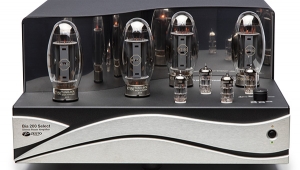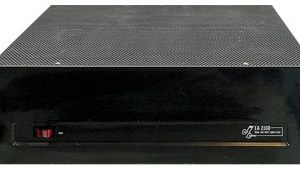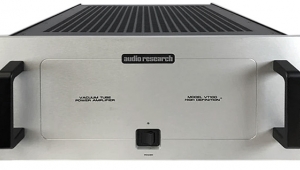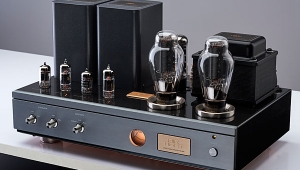| Columns Retired Columns & Blogs |
Balanced Audio Technology VK-150SE monoblock power amplifier
The VK-150SE stands tall at the top of Balanced Audio Technology's range. It and its smaller brother, the identical-looking VK-75SE stereo amplifier (or, sans the Special Edition mods, the plain VK-75, footnote 1), are related to BAT's first amplifier design, the VK-60. The company's partners, Victor Khomenko and Steve Bednarski, eventually realized that they'd made enough upgrades to the VK-60 to warrant a new model designation, and in 2000 they discontinued the VK-60. Bednarski explained that while the VK-60 accepted the upgrades with good results, the BATboys felt that, in order to fully realize the full potential of the 6H30 SuperTube, a new platform would be required. Enter the VK-75SE and VK-150SE.
Footnote 1: See Robert Deutsch's report in the July 2001 Stereophile (p.85) for the VK-60 to VK-75 takeoff, and the VK75 to '75SE jump to lightspeed.
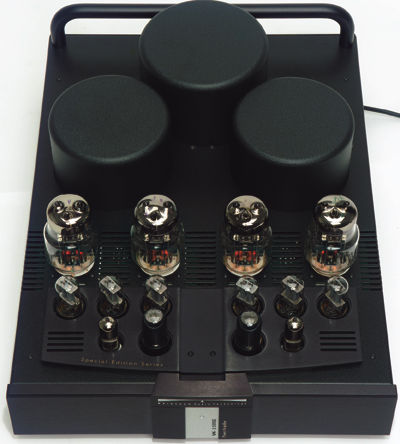
The main chassis of the high-tech VK-150SE is steel, and its overall build quality has resulted in a tight, nonresonant package. The front of the casework is highlighted by a black-and-silver faceplate machined from two pieces of solid aluminum that form a dished aluminum "wing," as BAT calls it. The wing incorporates cooling vents, plus open areas under the wing's leading outer edges that enhance natural convection cooling.
Each half of the wing houses one 6H30 SuperTube, which, according to Khomenko, functions as the heart of the amplifier circuit and is supported by a 6V6 tube used as a current source. This two-tube initial gain stage sits on a piggyback board atop the main channel board and is powered by its own dedicated supply. This, according to Victor Khomenko, endows the stage with high current capability, high transconductance, and low plate resistance, allowing the VK-150SE to "track amplitude changes in the musical signal with vanishingly low error."
A second row of three 6SN7 tubes function as the second gain stage and behind them are two chunky 6C33-C-B tubes. Everything is mirror-imaged on the other half of the chassis for what in the '75SE is the second channel and in the '150SE is the other half of the differential topology.
'Round back, the VK-150SE is simplicity itself. There are two balanced XLR inputs, one per channel for the VK-75SE. With the '150SE you can use either. There are two sets of speaker binding posts. Again, with the VK-150SE you can use either set. Moving the spades around according to the indicators will give you 4 or 8 ohm output transformer taps.
How's it sound?
I placed each amp, all 90 lbs of it, rather gingerly on a PolyCrystal stand. No other footers were used or even contemplated. I'm not that crazy.
Throughout Jacques Loussier Trio Plays Debussy (Telarc Jazz CD-83511), numerous bells are struck with various intensities. With the BAT VK-150SEs in the system, the superior cleanness, shimmer, and decay of the bells were immediately noticeable and quite pleasurable. But is it good to notice something in the playback that jumps out at you? As an audiophile, I say yes—as long as it adds to the musical enjoyment and doesn't become annoying over the long run. I never tired of hearing this album. Ever.
It was the same with the acoustic tailback decay of the vibes' shimmer on this recording—via the BAT monos they sounded fast, elegant, delightful, sensuous to experience, and quite lifelike.
How 'bout For the First Time, by the Count Basie Trio (Pablo PACD-2310-712-2)? Good Lord, does this old Pablo's restraint and beauty make me shiver with pleasure. Try the bass line on "Blues in the Alley." The VK-150SE did it incredibly well for a tube amp, with deep, delicious, powerful, strong fundamentals going way the heck down to the deck. The transition from the upper bass to the lower midrange was just about perfect: tuneful, tight, full, no slop, deep, powerful, with fine delineation of leading edges, and excellent and rich follow-on harmonics; more full, weighty, round, and—ultimately, surprisingly—deeper than the Paravicini M100A monoblocks that I reviewed last month or even the Linn Klimax.
The BAT's well-formed, fast, big, and luxurious tube-driven bass fundamentals got my attention and kept it! The Krell FPB 350Mc comes closest in the solid-state world to what the BAT was doin' with tubes. Both sounded delicious, wideband, and in control; the Krell simply had more authority down under. Of course, the BAT lacked the leading-edge impact in the bass that gives the Linn Klimax such slam.
Footnote 1: See Robert Deutsch's report in the July 2001 Stereophile (p.85) for the VK-60 to VK-75 takeoff, and the VK75 to '75SE jump to lightspeed.
- Log in or register to post comments
